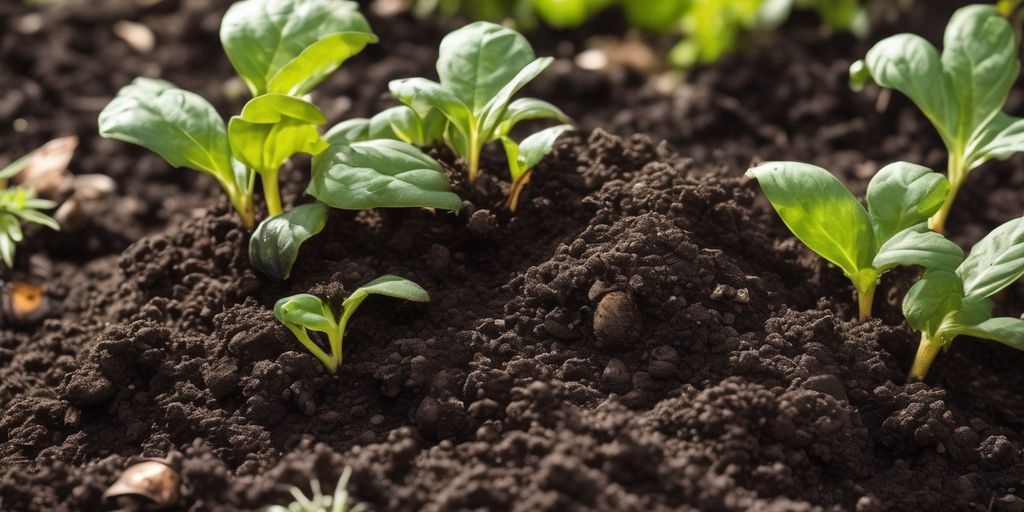Soil is a dynamic and essential component of gardening and agriculture, but its quality and effectiveness can degrade over time. Understanding the factors that influence soil health and how to maintain its quality can significantly impact the success of your gardening efforts. This article explores the nuances of soil degradation, the lifespan of potting soil, and practical measures to rejuvenate and store soil effectively.
Key Takeaways
- Soil doesn’t go bad overnight but can lose its benefits and nutritional value over time, especially once exposed after opening.
- Proper storage and care can extend the lifespan of potting soil, keeping it effective for up to two years after opening.
- Unopened potting soil doesn’t spoil but may lose nutrient efficacy after two years, as indicated by manufacturers.
- Reviving old soil involves recognizing signs of degradation and applying corrective measures to restore its health.
- Environmental factors such as moisture, light, and temperature play significant roles in the quality and lifespan of soil.
Understanding Soil Degradation
Signs of Soil Deterioration
Soil degradation is a critical issue where the soil loses its essential components, leading to reduced fertility and structure. Without these essential components, the soil becomes weak and crumbly, making it less capable of supporting plant life. Key signs include visible erosion, reduced crop yields, and a noticeable decrease in soil organic matter.
Factors Influencing Soil Quality
Various factors contribute to soil degradation, including the use of chemicals such as fertilizers and pesticides, which harm the soil’s natural balance. Other factors include:
- Erosion
- Compaction
- Nutrient imbalance
- Pollution
- Acidification
- Water logging
- Loss of soil biodiversity
- Increasing salinity
These factors collectively reduce the soil’s ability to support plant life and grow crops effectively.
Preventing Soil Degradation
To prevent soil degradation, it is crucial to adopt sustainable farming practices. These include minimizing the use of harmful chemicals, implementing crop rotation, and maintaining proper soil moisture levels. Additionally, restoring soil through methods such as adding organic matter can help rejuvenate degraded soils and enhance their productivity.
The Lifespan of Potting Soil
How Long Does Potting Soil Last?
Potting soil serves as an ideal medium for various gardening activities, but its nutrient-rich composition doesn’t maintain its quality indefinitely. Most potting soil is fortified with organic matter and beneficial microorganisms, which break down over time. The typical lifespan of potting soil can range from one to several years, depending on how it is used and stored.
Does Opened Potting Soil Go Bad?
Once opened, potting soil’s exposure to environmental factors like air and moisture can accelerate the degradation of its nutrients. While it doesn’t go bad in the traditional sense, its effectiveness for plant growth diminishes, making it less ideal over time. To extend the lifespan of your soil and maximize its effectiveness in nurturing plants, consider the following tips:
- Add fresh organic matter periodically.
- Ensure proper storage to minimize exposure to moisture and pests.
- Regularly check for and remove any clumps or mold.
Does Unopened Potting Soil Go Bad?
Unopened potting soil can maintain its quality for a longer period as it is protected from many external factors. However, the nutrient density can still degrade over time due to the natural breakdown of organic components. It is advisable to use potting soil within a few years of purchase to ensure the best results for your plants.
Reviving Old Soil
Steps to Rejuvenate Used Soil
Reviving old soil involves a series of steps to restore its fertility and structure. First, remove any old plant debris and weeds. Then, blend the soil with fresh organic matter such as compost or worm castings. It’s also beneficial to mix in perlite or vermiculite to improve drainage and aeration. Testing and adjusting the soil pH is crucial for optimal nutrient availability.
Common Mistakes to Avoid
When rejuvenating old soil, avoid overwatering and neglecting pH testing. Overwatering can lead to waterlogged soil which is detrimental to plant health. Additionally, failing to adjust the soil pH can prevent plants from absorbing nutrients effectively. Always ensure that the soil is not compacted; fluff it up to maintain proper aeration.
Tools and Supplements Needed
To effectively revive old soil, certain tools and supplements are essential:
- Soil pH tester: To check and adjust the soil’s pH.
- Compost and organic fertilizers: To replenish lost nutrients.
- Perlite or vermiculite: To enhance soil structure and drainage.
By using these tools and supplements, you can ensure that your old soil is brought back to life and made suitable for new plantings.
Proper Storage Techniques for Soil
Best Practices for Storing Opened Soil
To ensure the longevity and quality of opened soil, seal the bag tightly after each use to maintain moisture levels and prevent pest intrusion. Using proper containers, such as plastic totes or buckets with tight-fitting lids, can further protect the soil from contaminants and preserve its beneficial properties.
Ideal Conditions for Long-Term Storage
Store both opened and unopened soil in a cool, dry place, away from direct sunlight. Locations like garages, sheds, or basements are optimal. Avoid areas with extreme temperature fluctuations to prevent degradation of soil quality and nutrient loss.
Common Storage Mistakes
One of the most common storage mistakes is neglecting to seal the soil bag or container properly, which can lead to excess moisture and pest problems. Additionally, storing soil in direct sunlight or in fluctuating temperatures can significantly reduce its effectiveness and lifespan.
Impact of Environmental Conditions on Soil
Effects of Moisture and Light
Moisture and light are critical factors that influence soil health and its ability to support plant life. Excessive moisture can lead to soil compaction and reduced aeration, while insufficient moisture may cause the soil to become dry and nutrient-deficient. Light affects the temperature of the soil surface, which in turn influences microbial activity and nutrient availability.
Temperature and Soil Quality
Temperature plays a significant role in determining soil quality. Optimal soil temperatures promote beneficial microbial activity, which is essential for nutrient cycling and plant growth. Conversely, extreme temperatures can inhibit these processes and degrade soil quality.
Pests and Pathogens
Soil quality can be severely impacted by the presence of pests and pathogens. These organisms can disrupt the soil ecosystem, leading to a decrease in soil fertility and structure. Effective management strategies are crucial to mitigate the impact of these biological factors on soil health.
Sustainable Gardening with Recycled Soil
Benefits of Using Recycled Soil
Recycling soil not only reduces waste but also enhances the sustainability of gardening practices. Using recycled soil can significantly decrease the reliance on commercial potting mixes, which often come from non-renewable resources. Moreover, it helps in reducing the environmental footprint associated with the disposal of old soil.
How to Prepare Recycled Soil for Planting
To ensure that recycled soil is beneficial for plants, it must be properly prepared. Here’s a step-by-step guide:
- Remove any old plant debris and roots.
- Mix the soil with compost or other organic matter to replenish nutrients.
- Test the soil pH and adjust if necessary to meet the needs of the intended plants.
Long-Term Advantages of Soil Recycling
Recycling soil is not just a short-term solution for garden waste but a long-term strategy for sustainable gardening. It promotes a continuous cycle of reuse that benefits both the garden and the environment. Recycled soil maintains its quality over time, making it a reliable option for various gardening projects.
Recognizing When Soil is Beyond Recovery
Irreversible Soil Damage
In some cases, soil reaches a point where no amount of amendment can restore its original fertility. This is often due to severe contamination or prolonged neglect. Recognizing irreversible damage is crucial to avoid wasting resources on unrecoverable soil.
When to Discard Soil
There are specific scenarios where discarding soil is the most viable option. If the soil exhibits signs of heavy metal contamination, persistent pest infestations, or it has a completely altered structure, it might be time to replace it. This decision can save you from further plant health issues.
Alternatives to Disposing of Bad Soil
Instead of discarding bad soil, consider repurposing it for non-cultivation uses such as filling low spots in your yard or as a base for a new compost pile. This approach not only prevents waste but also contributes to a more sustainable gardening practice.
Conclusion
In conclusion, while soil does not ‘go bad’ in the traditional sense, its quality and effectiveness can degrade over time. Proper storage and maintenance can significantly extend the lifespan of potting soil, making it a sustainable choice for gardeners. By understanding the factors that affect soil health and learning how to rejuvenate old soil, gardeners can ensure their plants receive the necessary nutrients for optimal growth. Remember, proactive soil management is key to maintaining its benefits and extending its usability.
Frequently Asked Questions
Does soil go bad?
Soil does not go bad overnight or in a few days, but its quality can degrade over time, especially once exposed to elements like oxygen, light, and moisture.
How long does potting soil last once opened?
Once opened, potting soil can start to lose its nutrients over time. With proper storage and care, it can stay good for a long time, but it’s best used within a year or two for optimal plant health.
Does unopened potting soil go bad?
Unopened potting soil doesn’t ‘go bad’ or ‘spoil’ in the traditional sense, but its nutrient levels and efficacy may reduce after 2 years from the date of manufacture.
What are the signs of soil deterioration?
Signs include soil becoming dense and compacted, developing an unpleasant, sour, or moldy odor, and losing its loose, airy texture.
How can you rejuvenate old potting soil?
Rejuvenating old soil involves removing debris, adjusting pH levels, and enriching the soil with compost or other organic materials to restore its health.
What should you avoid when storing potting soil?
Avoid storing potting soil in areas with excess moisture, poor ventilation, or where it might be exposed to pests. Proper storage is crucial to maintaining soil quality.
Zaki Infitar is the driving force and creative mind behind GreenBuilt.co. As a self-taught gardener with an unwavering passion for all things green, Zaki’s journey into the world of gardening is a testament to his dedication and love for nature.

